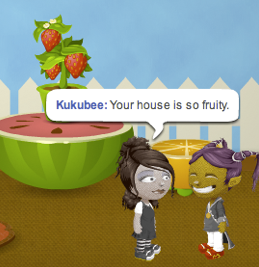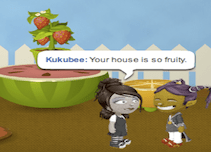 Starting next week, there’s a new massively multi-player online game launching in beta that you’re going to want to play. It’s called Glitch, and it’s been in the making for well over a year. From what I’ve seen, it will be well worth the wait.
Starting next week, there’s a new massively multi-player online game launching in beta that you’re going to want to play. It’s called Glitch, and it’s been in the making for well over a year. From what I’ve seen, it will be well worth the wait.
Over a year ago, I sat down with Tiny Speck (the company behind Glitch) co-founder Stewart Butterfield to go over some of the aspects behind the game. A few days ago, we caught up again to go over how far they’ve come leading up to the beta.
“We’ve been going hardcore for the last 18 months,” Butterfield says of the Tiny Speck team. “But only in the last four months have things gotten much clearer,” he continues. While they initially expected to launch in beta late last year, it has taken a bit longer than anticipated. But now he feels they’re ready to roll, undoubtedly helped by a big new influx of funding and a lot of new employees (they’re up to 22 now — minus former design lead Daniel Burka who moved on, but remains involved, Butterfield notes).
For the past six months, they’ve been testing Glitch with a select group of users for about a day every week. At most, there have been about 250 people at any given time testing it out. But with the beta, Butterfield expects to ramp that number up to 1,000 quickly. And the virtual world will be open about half of the time.
He expects the beta period to last anywhere from eight to fourteen weeks and over that time, they’ll let in the “tens of thousands” of users who have signed up to get early access (we have some cut-the-line invites below). They’ll be using a RockMelt-style invite system in which users are given invites and can easily see which of their friends want one.
In terms of the technology they’ve built to power the game, Butterfield seems most proud of the fact that they’ve brought a web-oriented approach towards software development to the game. He walked me through a bit of the backend to show me just how easy it is to tweak elements of the game on the fly, and to add new things.
A series of drop-down menus and pre-set data inputs makes this all possible. And it will allow Glitch to deploy in minutes what it has traditionally taken MMOs days or weeks to get out to their community. It will also allow for designers to push changes without having to bug the engineers.

The game itself is running on Amazon’s EC2 system. Butterfield notes that the biggest issue with that is the inter-sever traffic, but he says his team has engineered around many of those issues. They plan to stay on EC2 indefinitely partially due to what Butterfield learned with his previous startup, Flickr. “As a team we previously had to deal with storage requirements. If that can be someone else’s problem entirely, it’s better,” he says.
(He does acknowledge that at some point, assuming they grow quickly, it will make economic sense to have their own servers.)
The game itself is built entirely in Flash, which Butterfield notes can be a pain at times. But to get the polished look-and-feel that Glitch has, HTML5 simply is nowhere close where it needs to be, he says. “Maybe a couple years from now, but not now,” he says.
One of the most interesting aspects of Glitch is that they’ll have an API from day one that third-party developers can use to expand upon the game. In fact, some already are. Developers will be able to access Glitch characters that users create and do things such as modify them outside of the game, Butterfield says.
Eventually, this API is going to lead Glitch’s mobile approach as well. Because of the reliance on Flash, a mobile version of the game is unlikely anytime soon, but developers can come up with mini-games using the API, he notes. Butterfield says they’ll likely commission outside developers to do cool things on mobile devices and split revenues with them.
So where are the revenues going to come from? Glitch’s model is to be free for everyone, but they’ll have a subscription layer for the more hardcore players. These subscribers will have access to special features such as different character accessories.
There will also be in-game purchase options. Using a system Tiny Speck has built, users will be able to buy credits for something like 5.5 cents to 7.5 cents each. These can be used to buy power-ups and do things like teleportation to other areas in the game. Butterfield is quick to say though that they don’t want to make it easy for players to simply buy success.
PayPal payments should also be an option down the road. And eventually, Butterfield expects Facebook Credits to be a big part — Facebook still has to open these for use outside of their in-app ecosystem.
One thing that has surprised Butterfield so far is that while males make up the vast majority of the early testers, it’s females that are the most active players. This may speak well to the game’s appeal to a wide-range of players, as some of the most popular online games have similar ratios.
Again, while Glitch will launch in beta in a few days, there will still be a gradual roll-out to begin with. However, we’ve convinced them to give us 111 invites to cut the access line and get in front. So click this link and enter your email addresses quickly.
Update: And the invites are gone — in under 10 minutes, apparently there’s a lot of interest in this game.

